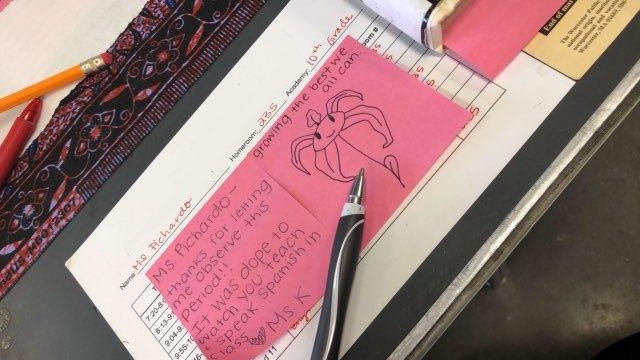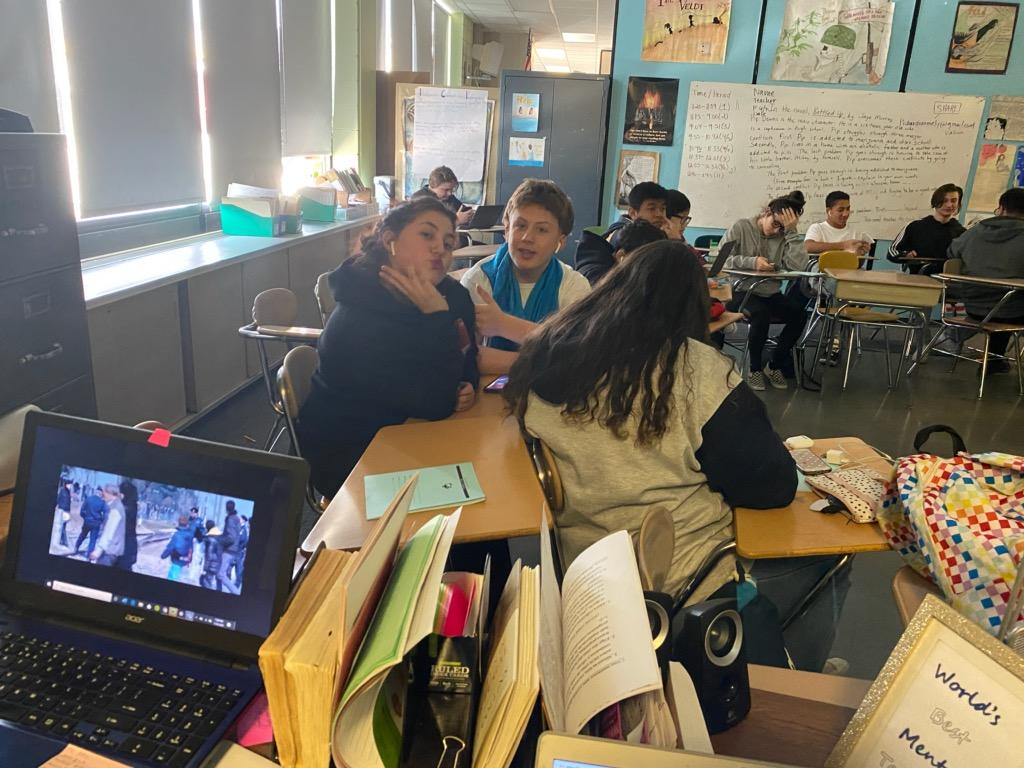 Over the past year, my teaching practice has grown in aspects beyond my imagination.
Over the past year, my teaching practice has grown in aspects beyond my imagination.
Confidence
My first day as a student teacher at South was truly nerve-wracking. A part of me was eager to meet all of my students and get to know them, but all I could really focus on that day was what kind of teacher I was going to become, and what would be my student’s response. I am pretty sure I spent the entire week stressing about the fact that I would soon be responsible for these student’s learning. Though I had previous coaching experience, creating my own lessons was often hard because (it took me all year to finally admit) I am a perfectionist. I had convinced myself that if students did not have fun while doing my work, they would refuse to learn. It was clear that though I was confident in interacting with students, I was completely terrified of being responsible for their learning.
My teacher confidence grew when I began asking for and receiving feedback from my students. This didn’t happen until I began to struggle teaching my first class. The first class I took over was a 10th grade college level English class at the end of the day. I struggled teaching this class because I felt that my lessons were not reaching every student. The diverse academic skills, and English language proficiency levels of this class’ population required much differentiation making me feel like my lessons were no longer as I had intended them. Though my students were still learning everyday, it felt like we were meeting different goals as a class. Having this class at the end of the day did not help much either, students found it difficult to stay focused because they had already attended 6 other subject courses before coming to my class. I decided to let my students become a part of the changes that needed to be made in our classroom. Together we discussed our struggles, identified what modes of learning and what types of lessons were most valuable and enjoyable, and how we could work together to create a safe learning environment. Soon after, I began to adjust my teaching practice and lessons, and felt confident that true and intentional learning was occurring daily in our English class.
For me, receiving feedback is just as important as giving it. My students would remind me daily that their goal was to make me cry by the end of the year, but they also would make me aware of my progress. Some students would thank me daily before leaving class, and others would reassure me that our classwork was allowing them to make significant progress in their reading and writing. As concerns around Covid-19 forced me to bid my students goodbye sooner than I expected, receiving this response from a student was a great and well-needed confident booster:
“I am gonna miss you ! you are an amazing teacher, and you only deserve the best. I may not be your Favorite student but you are always gonna be my favorite Teacher. Thank you so much for your hard work and I love you Ms. P. Thank you for emboldening me and appreciate it for teaching me.” -Sunita
Teacher Persona
My teacher persona is truly an extension of the many aspects that shape my identity. I am creative, funny, snappy, and super passionate about literature and anything that involves learning. When I began my practicum at South High, my role in the classroom for a while was to keep students on track by ensuring they were following classroom rules, translating assignments for students, and helping them stay focused in class. The proximity in age shared by students and I made them assume I would be a “cool teacher”. To many of my tenth grade students, a cool teacher would be someone young and cool who would allow them to slack off on classwork and use their phone. Fortunately, I was the complete opposite of that. I had high expectations for every student in my classes, and showcased those expectations with a very snappy attitude and a ton of tough love.
Throughout the year, my mentors suggested that exerting such an attitude towards these students could deteriorate our rapport and perhaps even damage the safe classroom environment I had worked all year to build. Though that was a cause for concern, I began to realize that my snappy attitude and tough love also held students accountable for all the goals we had set together in the beginning of the year. I also realized that the way I spoke to students was heavily influenced by the similarities in culture that my students and I shared, this allowed us to create relationships in which I could positively hold students accountable and motivate them to complete their work.
Eventually, I noticed that tough love did not work all the time, especially with my last period class. Sometimes, my students were facing challenges in their other classes or at home which changed the way in which they received my snappy remarks. I began to take notes of these situations and ensured I approached students in a more gentle manner when necessary. I also started to implement social emotional based bell-ringers which helped students and I reset the tone of the class, and allowed them to keep personal journals which they could share with me or keep at home. Overall, my teacher persona has become more dynamic allowing me to morph into a teacher that supports all students as individuals.
Setting Boundaries
Months into my placement at South High Community School, I found myself having a very hard time sleeping. Every conversation I had was surrounded around my students, their school, or the work we were doing in class. After taking over three sessions of 10th grade ELA, I learned that I quickly needed to set boundaries between my home and work life. Because my passion for teaching is heavily influenced by my own experiences as a learner, I constantly found myself worried about the challenges that many of my students faced at school and at home. Unfortunately, these were challenges beyond my control, and no matter how much I wanted to help in some instances I felt completely incapable of providing students with the academic and or emotional support that they needed.
The more I got to know my students, the more tempted I was to help them in any way that I could. I realized I had to set boundaries between my school and home life when I woke up from a nightmare which included one of my students. I had spent months trying to motivate this student to complete work in my class, until he eventually admitted to me that he struggled with reading and writing so much that he could never understand the directions on the board. This student was bright, had competed in professional soccer games, and even spoke three languages. I was in disbelief by his lack of reading and writing skill and even more shocked at the fact that he was not receiving any support that would allow him to gain the skills necessary to read and write in English. One night I dreamt of this student and woke up completely saddened by the way in which schools had failed him, but I realized that it was not solely my job to save him.
I began to find ways to support my students in different ways. I started to find other programs that already existed within the school, and referred students to those who could help. I implemented bell-ringers that asked questions focused on social emotional learning and it was a great way to continue helping my students without becoming overwhelmed myself. Most importantly, I used every chance I got to teach students to become advocates for themselves and what they believed in.



















